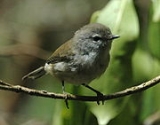
Brown Gerygone
Encyclopedia
The Brown Gerygone previously known as the Brown Warbler, is a small passerine
bird
native to eastern coastal Australia
. The upper parts of the Brown Gerygone are a deep olive-grey or olive-brown, while its face and underparts are a much paler grey, cream, or washed-out brown. The tail feathers are dark and may be white-tipped. It is approximately 10 cm in length.
The Brown Gerygone has a relatively large range. Although total population trends have not been quantified, it is considered of "least concern
" by the IUCN.
It may be sighted in coastal rainforest, singly or in small groups of two to four. It feeds on insects. The Brown Gerygone call is a soft what-is-it.
It is not closely related to either true Old World Warbler
s or the New World Warblers, but belongs rather to the Corvida
parvorder comprising many tropical and Australian passerines, as well as crow
s.
The Brown Gerygone is similar to both the Large-billed, G. magnirostris, and Mangrove,G. levigaster, Gerygones. It differs from the former by having a distinctive white eyebrow and a grey-tinged face. The Mangrove Gerygone, while having a white eyebrow, lacks the grey face, has more white on the flanks and has a redder eye.
Passerine
A passerine is a bird of the order Passeriformes, which includes more than half of all bird species. Sometimes known as perching birds or, less accurately, as songbirds, the passerines form one of the most diverse terrestrial vertebrate orders: with over 5,000 identified species, it has roughly...
bird
Bird
Birds are feathered, winged, bipedal, endothermic , egg-laying, vertebrate animals. Around 10,000 living species and 188 families makes them the most speciose class of tetrapod vertebrates. They inhabit ecosystems across the globe, from the Arctic to the Antarctic. Extant birds range in size from...
native to eastern coastal Australia
Australia
Australia , officially the Commonwealth of Australia, is a country in the Southern Hemisphere comprising the mainland of the Australian continent, the island of Tasmania, and numerous smaller islands in the Indian and Pacific Oceans. It is the world's sixth-largest country by total area...
. The upper parts of the Brown Gerygone are a deep olive-grey or olive-brown, while its face and underparts are a much paler grey, cream, or washed-out brown. The tail feathers are dark and may be white-tipped. It is approximately 10 cm in length.
The Brown Gerygone has a relatively large range. Although total population trends have not been quantified, it is considered of "least concern
Least Concern
Least Concern is an IUCN category assigned to extant taxon or lower taxa which have been evaluated but do not qualify for any other category. As such they do not qualify as threatened, Near Threatened, or Conservation Dependent...
" by the IUCN.
It may be sighted in coastal rainforest, singly or in small groups of two to four. It feeds on insects. The Brown Gerygone call is a soft what-is-it.
It is not closely related to either true Old World Warbler
Old World warbler
The "Old World Warblers" is the name used to describe a large group of birds formerly grouped together in the bird family Sylviidae. The family held over 400 species in over 70 genera, and were the source of much taxonomic confusion. Two families were split out initially, the cisticolas into...
s or the New World Warblers, but belongs rather to the Corvida
Corvida
The "Corvida" were one of two "parvorders" contained within the suborder Passeri, as proposed in the Sibley-Ahlquist taxonomy. Standard taxonomic practice would place them at the rank of infraorder....
parvorder comprising many tropical and Australian passerines, as well as crow
Crow
Crows form the genus Corvus in the family Corvidae. Ranging in size from the relatively small pigeon-size jackdaws to the Common Raven of the Holarctic region and Thick-billed Raven of the highlands of Ethiopia, the 40 or so members of this genus occur on all temperate continents and several...
s.
The Brown Gerygone is similar to both the Large-billed, G. magnirostris, and Mangrove,G. levigaster, Gerygones. It differs from the former by having a distinctive white eyebrow and a grey-tinged face. The Mangrove Gerygone, while having a white eyebrow, lacks the grey face, has more white on the flanks and has a redder eye.

